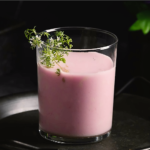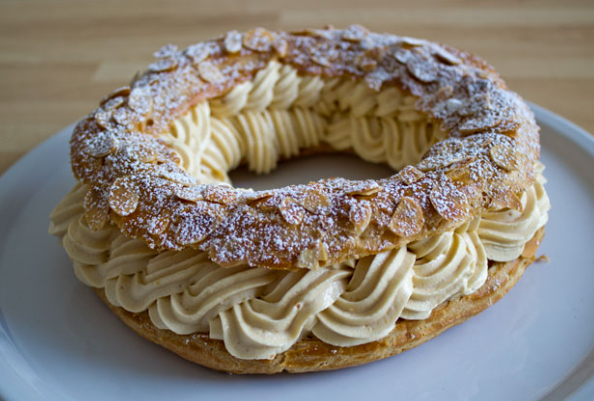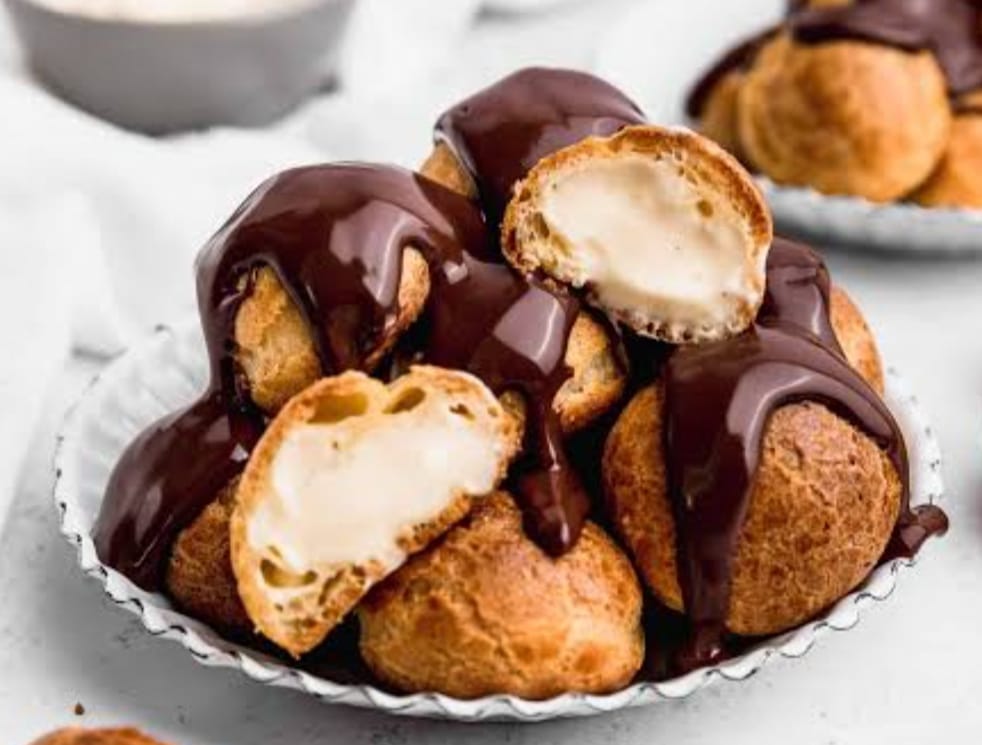Profiteroles are exquisite pastries crafted from airy choux dough that expands beautifully in the oven. After baking, they can be filled with an assortment of creamy delights, including whipped cream, custard, or ice cream. Typically drizzled with a luscious chocolate sauce, these pastries combine a crisp exterior with a soft, indulgent filling. Popular across various cultures, they can be served individually or presented as an elegant dessert arrangement.

What Are Profiteroles?
Profiteroles are small, round pastries made from choux pastry, known for their light and airy texture. They are typically filled with cream or custard and often topped with chocolate sauce or icing.
Profiteroles are Another pastry said to have been introduced to France by the entourage of the Medici family is the profiterole. This delightful French choux pastry ball is typically filled with whipped cream, custard, or ice cream, and often topped with powdered sugar, caramel, or chocolate.
The origins of choux pastry trace back to Italian chef Panterelli, whose recipe evolved over time until French patissier Jean Avice refined it into what we now recognize as choux buns. In the 18th century, chef Antoine Carême innovated by filling these choux pastries with cream, creating the profiterole as we enjoy it today. He also devised the spectacular profiterole tower, known as the croquembouche, which has become a popular choice for weddings in France.
History of profiterole :
Origins
- Italian Roots: Profiteroles trace their origins to choux pastry, which was created by Italian chef Pantarelli in the 16th century. This versatile pastry was used for both sweet and savory dishes.
Arrival in France
- Medici Influence: The pastry made its way to France with Catherine de Medici, who brought Italian chefs when she married Henry II in the 16th century. These chefs introduced various culinary techniques, including those involving choux pastry.
Evolution of Choux Pastry
- Refinement by Jean Avice: In the 19th century, French pastry chef Jean Avice significantly refined the choux pastry, improving its texture and expanding its use in desserts.
The Birth of the Profiterole
- Antoine Carême’s Contribution: In the 18th century, chef Antoine Carême took the choux pastry to new heights by filling it with cream or custard, thus creating the profiterole. He also introduced the croquembouche, a striking tower of profiteroles commonly served at weddings.
Modern Popularity
- Today, profiteroles are celebrated globally for their lightness and rich fillings. They come in various forms, including those filled with ice cream, and are enjoyed at both casual gatherings and formal celebrations.
Profiteroles continue to be a timeless French dessert, reflecting a blend of history and culinary innovation.
Profiteroles hold a special place in French cuisine for several reasons:
1. Culinary Heritage
Profiteroles are a classic French dessert with a storied history dating back to the 16th century, showcasing the skill and artistry inherent in French pastry-making.
2. Wide Range of Fillings
These delightful pastries can be filled with various creamy delights—such as whipped cream, custard, or ice cream—and topped with options like chocolate sauce or caramel, making them suitable for any occasion.
3. Stunning Presentation
Profiteroles are particularly impressive when arranged in a towering structure known as a croquembouche, often featured at weddings and festive events, which enhances their visual appeal.
4. Delicious Flavor and Texture
The airy choux pastry combined with rich, creamy fillings offers a delightful contrast, creating a dessert that is both satisfying and indulgent.
5. Cultural Importance
As a staple of French cuisine, profiteroles are commonly served during traditional celebrations, further solidifying their place as a beloved dessert.
In summary, the blend of historical significance, versatility, aesthetic charm, and delightful taste makes profiteroles a cherished treat in France.
Let’s see the simple and 5 steps recipe Profiterole:
Ingredients
- For the Choux Pastry:
- 1 cup water
- ½ cup unsalted butter
- 1 cup all-purpose flour
- 4 large eggs
- A pinch of salt
- Filling Options:
- Whipped cream, pastry cream, or ice cream
- For the Topping:
- Chocolate sauce or powdered sugar (optional)
Instructions
1. Prepare the Choux Pastry
In a saucepan, combine the water, butter, and salt, and bring to a boil. Once boiling, remove it from the heat and mix in the flour until the dough is smooth. Allow it to cool slightly.
2. Incorporate the Eggs
Gradually add the eggs one at a time, mixing well after each addition until the dough is shiny and smooth.
3. Pipe the Pastry
Preheat your oven to 400°F (200°C). Using a piping bag, pipe small rounds (about 1 inch in diameter) onto a baking sheet lined with parchment paper, leaving space between each.
4. Bake the Profiteroles
Bake for 20-25 minutes, or until the pastries are golden brown and puffed up. Be careful not to open the oven door during baking to keep them from deflating.
5. Fill and Serve
Once the profiteroles have cooled, either cut them open or fill them using a piping bag with your desired filling. Optionally, drizzle with chocolate sauce or dust with powdered sugar before serving. Enjoy!
Happy baking!
Tips for making profiteroles at home:
1. Gather Your Ingredients
Before you start, have all your ingredients measured and ready to go. This helps streamline the process and ensures you don’t miss anything.
2. Use Fresh Ingredients
Make sure your eggs and dairy are fresh for the best flavor and texture. This can make a noticeable difference in the final product.
3. Cook the Dough Properly
When heating the water and butter, bring it to a boil before adding the flour. Stir vigorously until the mixture forms a smooth ball and pulls away from the sides of the pan.
Enjoy your Homemade Profiteroles!!
Also You can try this Profiteroles with cardamom crème fraîche and orange toffee sauce.











Leave a Reply